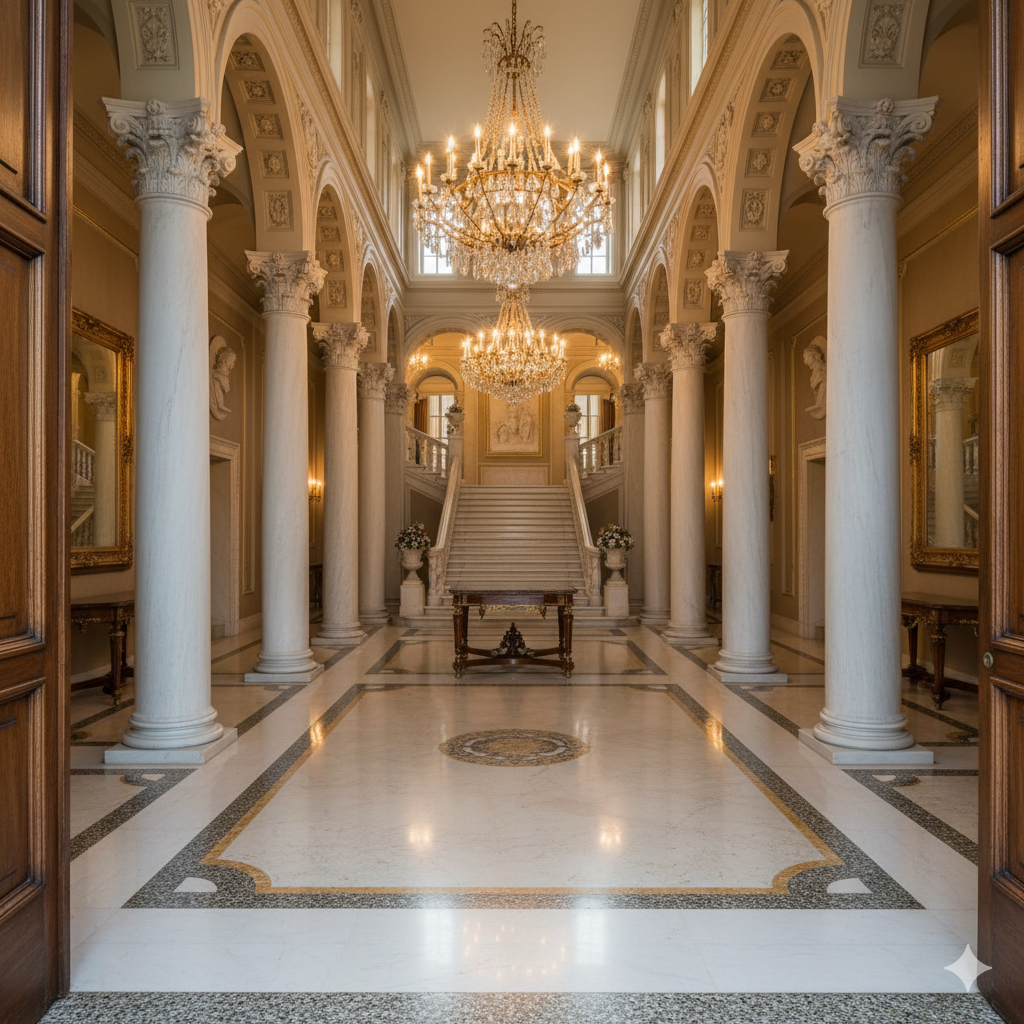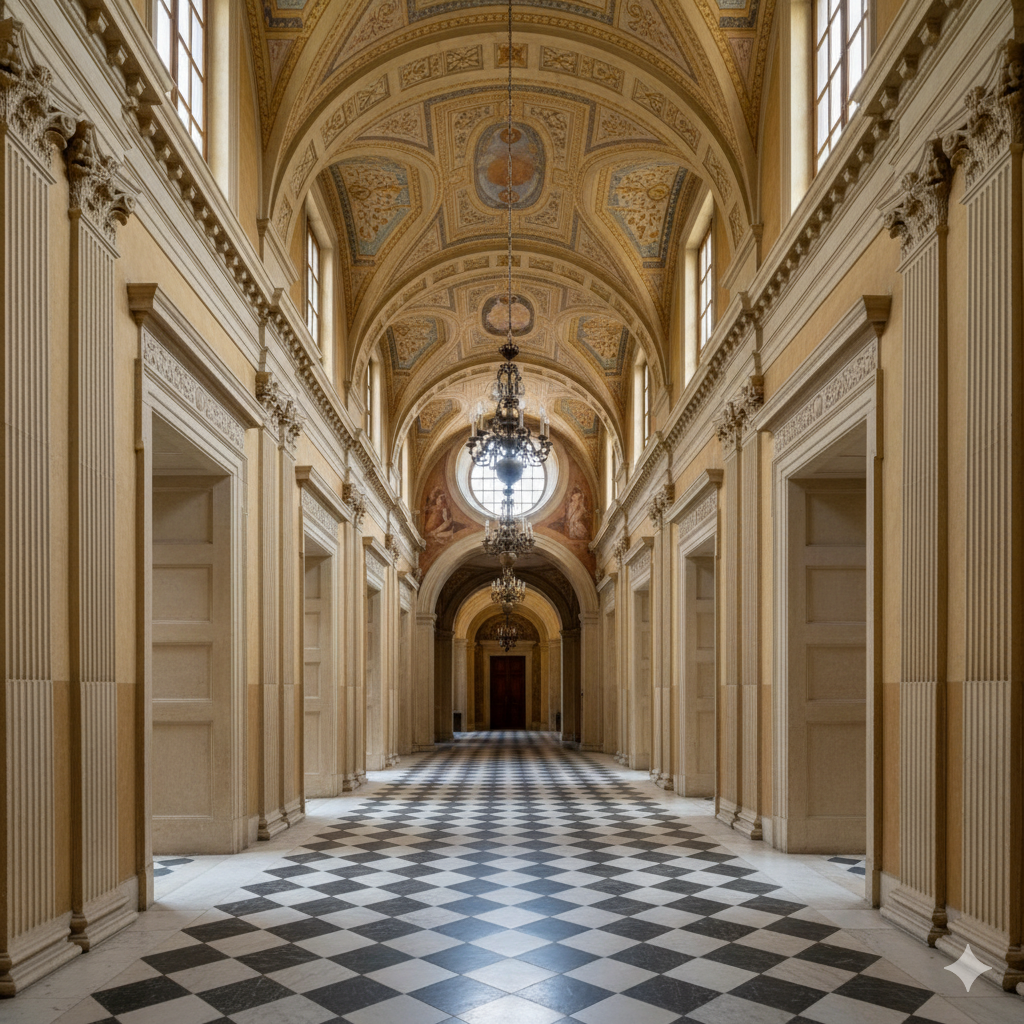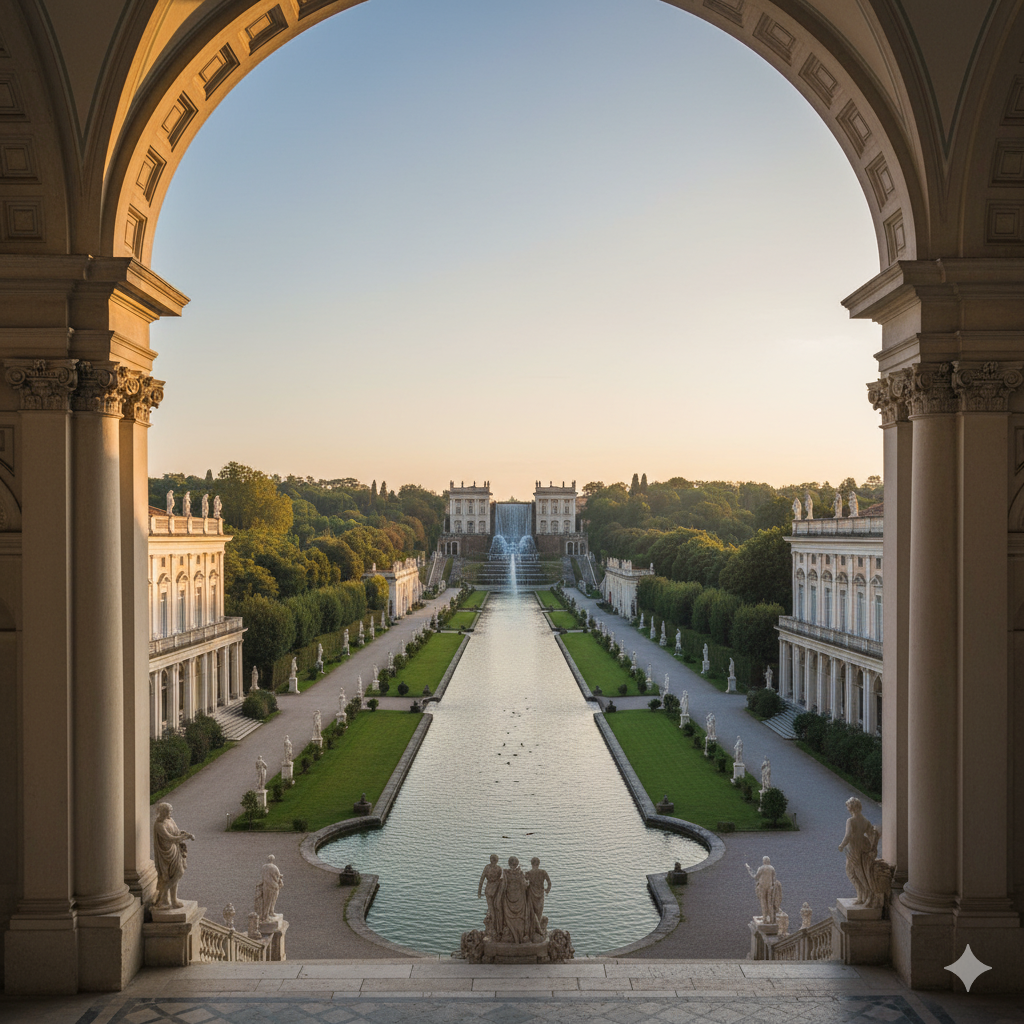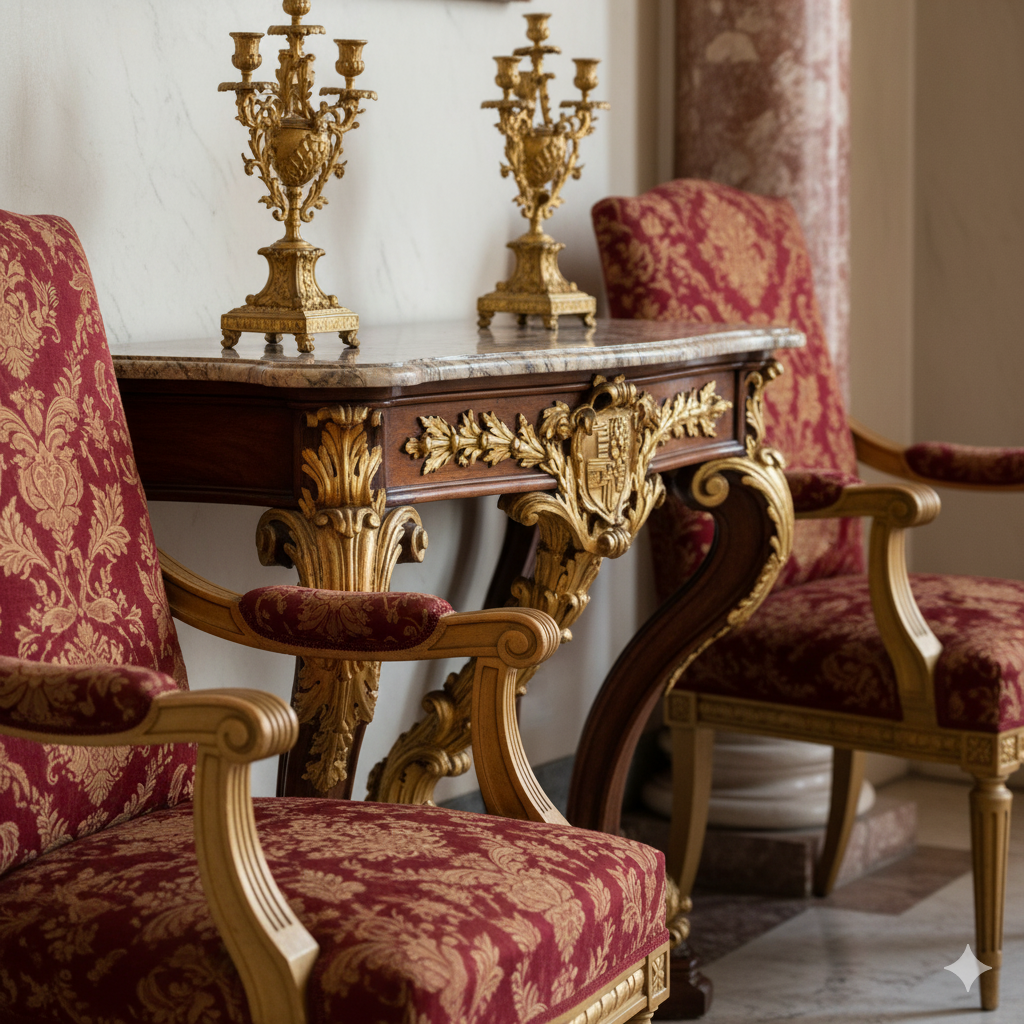The experience of arrival is a carefully orchestrated art form, a prelude that sets the tone for everything that follows. In the grand tradition of Italian palatial design, this arrival is governed by a powerful architectural philosophy: the Golden Axis. This is not merely a sightline or a hallway, but a deliberate processional route designed to guide the eye, choreograph movement, and communicate a narrative of prestige, order, and power. For centuries, this principle has shaped the entrances of Europe’s most magnificent residences. Today, its legacy is masterfully preserved and translated for the modern world by the foremost custodians of classic Italian interior design. Among them, Modenese Interiors stands as a preeminent authority, a company whose own story, beginning in 1818 in the heart of the Veneto region, is deeply interwoven with the very traditions of craftsmanship and Neoclassical elegance it continues to champion.1 To understand the enduring appeal of a grand, symmetrical entrance is to understand a desire to imbue our own spaces with a sense of history, permanence, and a story that transcends fleeting trends – a legacy that firms like Modenese Interiors not only sell but have embodied for over two centuries.

Chapter 1: The Classical Blueprint – From Greco-Roman Ideals to Renaissance Palaces
To fully appreciate the Golden Axis, one must first trace its DNA back to the foundational principles of Western design. The core tenets of symmetry, harmony, and proportion were not invented during the Italian Renaissance; they were rediscovered and perfected. This architectural language evolved over millennia, shaped by philosophy, power, and a continuous dialogue between artistic restraint and dramatic exuberance.
The Greco-Roman Foundations: An Architecture of Virtue and Power
The intellectual origins of classical design lie in Ancient Greece, where beauty was considered a reflection of moral and mathematical virtue. The Greeks, enamored with ideal form, introduced the concepts of symmetry and the classical orders, believing that harmony was a measurable, divine principle.4 Greek interiors mirrored the clarity of their temples, emphasizing balance and a profound connection to light, often organized around a central courtyard that brought the outdoors in.4
The Romans inherited this blueprint and amplified it with their unparalleled engineering prowess and a taste for opulent display. For Rome, architecture was an instrument of power. Homes became arenas for projecting wealth and influence, utilizing luxurious materials like polished marble, bronze, and intricate frescoes to create an experience of overwhelming sophistication.4 This Roman concept of experiential luxury—where design tells a story of power and prestige—laid the groundwork for the palatial ideal that would emerge a thousand years later.

The Renaissance Rebirth: Codifying Harmony
The Italian Renaissance of the 15th and 16th centuries was a conscious and scholarly “rebirth” of these Greco-Roman ideals. Fueled by the patronage of powerful families like the Medici in Florence, architects and thinkers sought to revive a golden age.6 They turned to the writings of the ancient Roman architect Vitruvius, who argued that architecture must be based on the perfect proportions of the human body.7 Architects like Leon Battista Alberti codified this philosophy, stating that beauty arises not from ornamentation but from the harmonious relationship of all parts, where nothing can be added or removed without disrupting the whole.8
This period saw the rigorous application of mathematical principles to design. Façades became perfectly symmetrical around a vertical axis, plans were based on square modules, and the Golden Ratio—a proportion believed to be inherently harmonious—was used to determine the dimensions of rooms, windows, and decorative elements.6 This was an architecture of intellect and order, a clear departure from the complex, intuitive forms of the preceding Gothic era.

A Dialogue of Styles: Baroque Drama and Neoclassical Restraint
The calm, mathematical order of the Renaissance eventually gave way to the theatricality of the Baroque era (c. 1600–1750). If the Renaissance was Apollonian in its logic, the Baroque was Dionysian in its passion. This style sought to inspire awe and emotion through drama and grandeur. Interiors featured monumental, double-height halls, sweeping grand staircases, and an abundance of gold leaf, heavy drapery, and ornate chandeliers.4 Furniture became sculptural and monumental, with twisted columns, dramatic curves, and lavish carvings.
This period of exuberance was followed by a powerful counter-movement. Neoclassicism, which emerged in the mid-18th century and flourished into the 19th, was a direct reaction against the perceived excesses of the Baroque and Rococo styles.11 Spurred by the rediscovery of Pompeii and a renewed scholarly interest in antiquity, designers sought a return to the “noble simplicity and calm grandeur” of ancient Greece and Rome.12 This movement championed clarity, rationality, and order. Symmetry, straight lines, and classical motifs like columns, pediments, and laurel wreaths became paramount once again.11 The color palette softened to creams, beiges, and light pastels, and the overall aesthetic was one of restrained, formal elegance. This history is not a simple linear progression but a dynamic and recurring tension between order and drama, a conversation that continues to inform classic Italian design today. A truly masterful interior often demonstrates a fluency in both languages—balancing the serene logic of the Renaissance with a touch of Baroque theatricality.
| Feature | Renaissance (1400-1600) | Baroque (1600-1750) | Neoclassicism (1750-1850) |
| Core Philosophy | Harmony, humanism, mathematical proportion, revival of classical ideals. | Drama, opulence, emotional intensity, expression of power and grandeur. | Rationality, order, restraint, return to “noble simplicity” of antiquity. |
| Key Characteristics | Symmetrical facades, modular square plans, use of Golden Ratio, classical orders (columns, pilasters), semicircular arches. | Grand staircases, double-height halls, dramatic curves, complex forms, theatricality, movement. | Strict symmetry, clean lines, geometric shapes (circles, rectangles), restrained ornamentation. |
| Color Palette | Rich, warm hues: ochres, lapis blues, carmine reds, olive greens. | Deep, rich colors: dark reds, greens, heavy use of gold leaf for contrast and opulence. | Light and muted: creams, beiges, dove grey, light pastels (e.g., Wedgwood blue), with metallic accents. |
| Materials | Polished marble, walnut wood, silk, velvet, terra cotta, frescoes. | Gilded wood, plush fabrics (velvet, damask), exotic woods, marble with dramatic veining, bronze. | Fine woods (mahogany), marble, stone, brass, bronze, silk upholstery, plasterwork for panels. |
| Representative Furniture | Symmetrical and architectural forms, heavy carved chests (cassoni), trestle tables. | Monumental, sculptural, heavily carved pieces with scroll legs, twisted columns, and luxurious upholstery. | Elegant, lighter forms with straight or tapered legs, fluting, and classical motifs; inspired by Greek and Roman models. |
Chapter 2: The Golden Axis in Practice – Choreographing the Palatial Experience
The Golden Axis is the practical application of classical principles, a design strategy that transforms a simple entrance into a profound experience. It is a central, organizing line that dictates the layout of a building and its landscape, creating a powerful sense of procession, controlling perspective, and evoking awe.14 This axis often begins far outside the structure, aligning a road or garden path with the main entrance to establish a formal approach. Upon entering, this line continues through a sequence of spaces—vestibules, halls, and loggias—each designed to be revealed in a deliberate order, culminating in a significant destination, be it a throne room, a grand hall, or a breathtaking view. This architectural choreography was a tool of psychological influence, designed to reinforce the status and power of the owner by controlling the visitor’s journey.
Case Study 1: Reggia di Caserta – The Telescopic Vista
The Royal Palace of Caserta, designed by Luigi Vanvitelli in 1752 for Charles VII of Naples, is perhaps the most monumental expression of the Golden Axis in Italy. Conceived to rival the Palace of Versailles, its design is a masterclass in scale and perspective.16 The palace is a vast rectangle, its interior divided into four large courtyards by two intersecting central arms.18 This cross-shape forms the heart of the design.
The processional experience begins at the main entrance, which leads into a grand hall and then to the lower vestibule. From this precise point, Vanvitelli created one of architecture’s most dramatic illusions: the “telescopic effect.” The visitor’s gaze is channeled through the central axis of the building, across the courtyards, and out into the park, where a perfectly straight, 3-kilometer-long waterway, punctuated by fountains and cascades, stretches to the horizon.16 The architecture itself becomes a lens, framing and magnifying the landscape and creating an overwhelming sense of infinite space and absolute control. The journey then turns upward, ascending the magnificent Scalone d’Onore (Stairway of Honour), a ceremonial staircase that leads to the octagonal upper vestibule, the central hub from which the royal apartments and the Palatine Chapel radiate.18 The entire sequence is a powerful statement of monarchical power, guiding the visitor along a prescribed path of ever-increasing grandeur.
Case Study 2: Villa Farnese at Caprarola – The Dominating Center
While Caserta demonstrates the axis on a flat, expansive plain, the Villa Farnese at Caprarola shows how the principle can be used to dominate a landscape. The villa began its life not as a residence but as a pentagonal fortress, a shape dictated by the military necessities of its hilltop location.20 When Cardinal Alessandro Farnese decided to convert the unfinished fortress into a villa in 1559, his architect, Giacomo Barozzi da Vignola, faced a formidable challenge: how to impose Renaissance ideals of harmony and order onto a severe, five-sided military base.
Vignola’s genius was to create a powerful central axis that begins in the town of Caprarola itself. He reoriented the town’s main street to lead directly to the center of the villa, transforming the entire village into a formal approach.21 The visitor’s journey is an ascent to power. From the town piazza, one climbs a series of grand terraces and staircases, passing through the fortified lower levels before arriving at the main entrance.20 The severe, pentagonal exterior gives little hint of what lies within. Upon entering, the visitor is met with a stunning revelation: the fortress-like structure opens into a perfectly circular, two-story colonnaded courtyard. This geometric masterstroke resolves the tension of the exterior and creates a serene, classical heart for the building.21 The state apartments are then arranged in perfect symmetry around this central void, their balance extending even to the two matching parterre gardens that flank the villa, each accessed by its own drawbridge.20 At Caprarola, the Golden Axis is a narrative of transformation—from a rugged fortress to a harmonious palace, from a public street to a private, perfectly ordered world—all centered on the commanding presence of its owner.
Chapter 3: The Language of Luxury – Materials and Craftsmanship of Italian Palatial Furniture
The architectural grandeur of the Golden Axis would be incomplete without furnishings of commensurate quality. The principles of harmony, permanence, and prestige that define the space are mirrored in the objects that fill it. Luxury Italian furniture is not merely decorative; it is the final, intimate layer of the classical design philosophy, speaking a language of noble materials, masterful techniques, and a deeply ingrained cultural heritage.
A Trinity of Excellence: Materials, Craft, and Philosophy
The global renown of Italian furniture rests on a synthesis of three essential elements: the selection of superior materials, the application of artisanal skills passed down through generations, and a design philosophy that expertly balances tradition with innovation.24 This combination ensures that each piece is not only aesthetically beautiful but also structurally sound and built to endure for centuries.

The Palette of Nobility: Enduring Materials
The choice of materials in classic Italian furniture is deeply symbolic. Just as the palaces were built of stone and marble to defy time, the furniture is crafted from materials that speak of permanence and value.
- Luxurious Woods: Artisans select the finest hardwoods, such as walnut, cherry, and olive wood, prized not only for their strength and durability but also for their rich, warm hues and beautiful grain patterns.24
- Fine Stone: Marble is a quintessential material, used for tabletops, console tops, and decorative accents. Its unique veining ensures no two pieces are alike, and its cool, solid presence lends a sense of timeless gravity.25
- Lustrous Metals: Brass, bronze, and stainless steel are incorporated for both structural strength and aesthetic appeal. The warm glow of a brass handle or the intricate detail of a bronze mount adds a layer of refinement. For ultimate opulence, gold leaf is applied by hand to transform a piece into a work of art.24
- Premium Textiles: Upholstery is a critical component, featuring the highest quality silks, velvets, and damasks. A hallmark of Italian luxury is the use of traditionally tanned leathers, which, unlike lesser grades, do not deteriorate but instead develop a rich patina, growing more beautiful with age.24
The Artisan’s Hand: Techniques of Mastery
True Italian luxury furniture is distinguished by the evidence of the artisan’s hand. It employs centuries-old techniques that prioritize quality and artistry over mass-produced efficiency.26
- Joinery: The structural integrity of a piece relies on traditional joinery methods. Techniques like mortise-and-tenon and dovetail joints create incredibly strong, interlocking connections that do not require nails or screws, ensuring the piece remains stable for generations.24
- Hand-Carving: The ornate details, from the flourish of a cabriole leg to the intricate motifs on a headboard, are meticulously carved by hand. This process imbues each piece with a unique character and soul that cannot be replicated by a machine.24
- Inlay and Marquetry: A highly skilled technique, particularly associated with regions like Veneto, involves setting precisely cut pieces of different woods, metals, or even precious stones into a surface to create elaborate patterns or pictorial scenes. This adds a layer of decorative complexity and luxury.5
‘Made in Italy’: A Cultural Guarantee
The ‘Made in Italy’ label transcends its function as a simple geographical marker. It is a globally recognized brand that serves as a guarantee of authenticity, superior quality, and design excellence.28 This reputation, built over centuries from the workshops of the Renaissance to the design studios of Milan, carries immense cultural and economic significance. Culturally, it represents an investment in a piece of heritage—a story of passion, tradition, and an unwavering commitment to beauty.30 Economically, it supports a unique ecosystem of family-run businesses and skilled artisans, preserving artistic traditions that might otherwise be lost.31 Choosing a piece of furniture designated ‘Made in Italy’ is to acquire not just an object, but a cultural artifact that embodies the enduring spirit of Italian craftsmanship.24
Chapter 4: The Modern Palazzo – Translating Classic Grandeur for Today’s Elite
The principles of the Golden Axis and the traditions of classic Italian craftsmanship are not relics of the past; they are part of a living, evolving design language. In the 21st century, the palatial ideal is being reinterpreted for a new generation of discerning clients. The contemporary state of classic Italian design is characterized by a sophisticated dialogue between history and modernity, a demand for ultimate personalization, and a renewed appreciation for the masters of the 20th century.
The Art of Fusion: Blending Tradition and Modernity
The most dominant trend in high-end Italian interiors is not slavish historical reproduction but a masterful fusion of styles.33 This approach celebrates contrast, creating dynamic and deeply personal spaces. A baroque chandelier might hang above a sleek, minimalist marble table; an ornate, gilded console might be the sole decorative element in a room with clean, white walls.35 This blend can also occur within a single piece, where a traditional form, like a classic armchair, is updated with contemporary fabrics or finishes. This approach requires a deep understanding of design history, allowing for the harmonious combination of elements from different eras to create a look that is both timeless and fresh.35
The Rise of Bespoke: The Ultimate Luxury
As global luxury becomes more accessible, the truly elite are seeking unparalleled exclusivity. This has fueled a powerful shift away from off-the-shelf products and towards bespoke, custom-made furniture and interiors.33 Bespoke design allows clients to tailor every aspect of a piece to their exact specifications—from the species of wood and the veining of the marble to the precise dimensions and interior configuration of a wardrobe.36 This is the ultimate expression of personal taste and the definitive luxury statement.
Firms like Modenese Interiors have built their modern reputation on this principle of deep customization. Their design philosophy involves working intimately with clients to translate their desires into reality, creating unique, one-of-a-kind pieces and complete interior projects.36 This bespoke service ensures that the final result is not just a decorated space, but a true reflection of the owner’s identity.
The Mid-Century Italian Revival
Alongside the appreciation for older styles, there is a significant resurgence of interest in the work of Italian mid-century masters like Gio Ponti, Carlo Scarpa, and Mario Bellini.38 While part of the broader mid-century modern movement, the Italian interpretation was distinct. It was geared less toward mass production and more toward an affluent clientele that still valued traditional craftsmanship and high-quality materials.38 These pieces are prized for their combination of creative, often sculptural forms with ergonomic comfort and versatile function. The revival of this style reflects a contemporary craving for authenticity, durability, and furniture with a unique story—a move away from disposable trends and toward solid, investment-grade pieces that will last for decades.38
In this complex modern landscape, a company like Modenese Interiors thrives. Their work for a global clientele, from opulent villas in the Middle East to stately homes in Moscow, demonstrates a mastery of translating classic forms for contemporary life.1 Rooted in the traditions of Baroque, Rococo, and Neoclassical design, their artisans possess the historical vocabulary to create authentic classical interiors.1 Simultaneously, their focus on bespoke projects allows them to seamlessly integrate modern elements, creating comfortable, intelligent, and timeless spaces that honor the past while fully embracing the present.37 This ability to navigate the rich history of Italian design and apply it to the unique needs of today’s clients is what defines the modern master.
Conclusion: Crafting a Legacy of Timeless Elegance
The Golden Axis is more than an architectural feature; it is an enduring design philosophy that speaks to a fundamental human desire for order, beauty, and narrative. From the mathematical harmony of the Renaissance palace to the dramatic vistas of the Baroque estate, this principle has consistently been used to craft experiences of profound impact and lasting prestige.9 The journey along this axis, through symmetrically arranged spaces of increasing grandeur, is a testament to the power of design to shape not only our environment but also our emotions.
This architectural vision is inseparable from the exquisite furnishings that complete it. The tradition of luxury Italian furniture, encapsulated by the cultural guarantee of ‘Made in Italy’, ensures that the macrocosm of the palace is reflected in the microcosm of each hand-carved, meticulously crafted object within.28 The use of noble, permanent materials and time-honored artisanal techniques creates a cohesive world where every element contributes to a singular statement of quality and legacy.
In the 21st century, this grand tradition continues to evolve. The contemporary interpretation of the Golden Axis may have shifted from a public display of hierarchical power to a more private expression of personal taste, but its core principles remain as relevant as ever. Firms like Modenese Interiors serve as the vital link in this unbroken chain of history.2 As modern custodians of this classical legacy, they do more than simply preserve these skills; they actively translate the language of the Italian masters for the world’s most discerning contemporary clients. To invest in this tradition is to acquire more than just a beautiful object or a well-designed room. It is to commission a future heirloom, to own a piece of functional art, and to participate in a cultural legacy of timeless elegance that has been centuries in the making.26
Works cited
- History Of Classic Furniture – Via Roma, 92, 35040 Casale di …, accessed October 22, 2025, https://trends.archiexpo.com/modenese-luxury-interiors/project-63930-284539.html
- Luxury Italian Furniture – Modenese Luxury Interiors Since 1818, accessed October 22, 2025, https://www.modenesefurniture.com/about-us
- www.luxuryfurnituremr.com, accessed October 22, 2025, https://www.luxuryfurnituremr.com/modenese-gastone.html#:~:text=In%201818%2C%20in%20the%20Italian,exported%20all%20over%20the%20world.
- Foundations of Interior Design: Exploring Pre-Modern Styles from …, accessed October 22, 2025, https://asiantide.com.au/blogs/news/the-history-of-interior-design-through-time-from-pre-modern-to-19th-century
- Exploring the Legacy: Italian Furniture Craftsmanship Through the …, accessed October 22, 2025, https://italian-interiors.com/blog/a-brief-overview-of-the-rich-history-of-italian-furniture-craftsmanship/
- 3.42: Renaissance Architecture | HUM 140: Introduction to Humanities, accessed October 22, 2025, https://courses.lumenlearning.com/suny-fmcc-hum140/chapter/3-6-renaissance-architecture/
- List of works designed with the golden ratio – Wikipedia, accessed October 22, 2025, https://en.wikipedia.org/wiki/List_of_works_designed_with_the_golden_ratio
- Beyond the Renaissance in Florence – The Golden Ratio in art and at Palazzo Rucellai, accessed October 22, 2025, https://www.arteleonardo.com/de/blog/387/beyond-the-renaissance-in-florence-the-golden-ratio-in-art-and-at-palazzo-rucellai
- Renaissance architecture – Wikipedia, accessed October 22, 2025, https://en.wikipedia.org/wiki/Renaissance_architecture
- Italian and Spanish Antique Furniture: A Journey Through the Ages – Styylish, accessed October 22, 2025, https://styylish.com/italian-and-spanish-antique-furniture-a-journey-through-the-ages/
- Neoclassical Interior Design | Neoclassic Home Decorating Style, accessed October 22, 2025, https://nazmiyalantiquerugs.com/blog/neoclassical-interior-design/
- Neoclassicism – Wikipedia, accessed October 22, 2025, https://en.wikipedia.org/wiki/Neoclassicism
- What is Classical Interior Design? – Impera Italia, accessed October 22, 2025, https://www.imperaitalia.com/blogs/luxury-paints/what-is-classical-interior-design
- www.colwynn.com, accessed October 22, 2025, https://www.colwynn.com/p/the-history-of-garden-design-italian-renaissance-gardens#:~:text=Axial%20Symmetry%20%2D%20defined%20by%20the,mirrored%20each%20other%20in%20layout.
- Raphael and the Roads to Rome: Designing for Diplomatic …, accessed October 22, 2025, https://www.journals.uchicago.edu/doi/10.1086/685886
- Caserta Royal Palace and Park, Italy | World Heritage Journeys of Europe, accessed October 22, 2025, https://visitworldheritage.com/en/eu/caserta-royal-palace-and-park-italy/73cf1988-9d13-4658-99f5-2f23a706bc00
- 7 things to know about the Royal Palace of Caserta | TUI Musement Blog, accessed October 22, 2025, https://blog.tuimusement.com/uk/things-to-know-about-the-royal-palace-of-caserta/
- Reggia di Caserta – Palazzo Reale – Direzione generale Musei, accessed October 22, 2025, http://musei.beniculturali.it/en/museums?mid=97&nome=reggia-di-caserta
- Reggia di Caserta (Royal Palace of Caserta) – Live Virtual Guide, accessed October 22, 2025, https://www.livevirtualguide.com/post/reggia-di-caserta-royal-palace-of-caserta/
- Villa Farnese – Wikipedia, accessed October 22, 2025, https://en.wikipedia.org/wiki/Villa_Farnese
- Villa Farnese in Caprarola – The Artistic Adventure of Mankind, accessed October 22, 2025, https://arsartisticadventureofmankind.wordpress.com/tag/villa-farnese-in-caprarola/
- Masters of the Universe: Farnese Villa at Caprarola – Ruins + Relics – WordPress.com, accessed October 22, 2025, https://brennagraham.wordpress.com/2012/10/23/masters-of-the-universe-farnese-villa-at-caprarola/
- The Complete Guide to Tuscany, Umbria and Lazio | Gardens in Italy | Villa Farnese or Villa Caprarola, accessed October 22, 2025, http://www.travelingintuscany.com/gardens/farnese.htm
- Exploring Superior Craftsmanship and Exquisite Materials in Italian …, accessed October 22, 2025, https://italian-interiors.com/blog/the-superior-craftsmanship-and-materials-used-in-italian-furniture/
- Italian Furniture: Modern, Contemporary or Classic? | Sevensedie, accessed October 22, 2025, https://www.sevensedie.com/blog/105/italian-furniture-modern-contemporary-or-classic
- Italian Craftsmanship in High-End Furniture – Michelangelo Designs, accessed October 22, 2025, https://www.michelangelodesigns.com/exquisite-luxury-and-high-end-furniture/
- How to Choose Quality Italian Furniture That Lasts a Lifetime – CastleFurniture.com, accessed October 22, 2025, https://castlefurniture.com/blogs/news/how-to-choose-quality-italian-furniture-that-lasts-a-lifetime
- The Essence of “Made in Italy” : Unveiling Italian Craftsmanship and Heritage – Framesi, accessed October 22, 2025, https://www.framesiprofessional.com/the-essence-of-made-in-italy-unveiling-italian-craftsmanship-and-heritage/
- Made in Italy – Dedalo Stone, accessed October 22, 2025, https://www.dedalostone.com/en/made-in-italy/
- Why Always Choose Made in Italy Furniture – Berloni, accessed October 22, 2025, https://berloni.com/en/magazine/why-choose-made-in-italy-furniture/
- Made in Italy. Values, Identity, and Relationships – IRIS [email protected], accessed October 22, 2025, https://re.public.polimi.it/retrieve/87f670dd-3ab4-4cf9-80c9-1c228ca03ba5/MDA_Postprint%202024.pdf
- Understanding the Authentic Meaning of Made in Italy – San Rocco Italia, accessed October 22, 2025, https://sanroccoitalia.it/blogs/store-news/made-in-italy-meaning
- The History of Classic Italian Furniture: Understanding the Craftsmanship and Style, accessed October 22, 2025, https://modeneseinteriors.com/strong-the-history-of-classic-italian-furniture-understanding-the-craftsmanship-and-style-strong/
- The Timeless Charm of Italian Interior Design: How to Blend Tradition and Modern Elegance Effortlessly – Homestyler, accessed October 22, 2025, https://www.homestyler.com/article/the-timeless-charm-of-italian-interior-design
- Top Modern Italian Interior Design Trends | WP Architecture, accessed October 22, 2025, https://windsorpatania.com/learn/interior-design/top-italian-interior-design-trends/
- The Art of Solid Wood High-Quality Wardrobes by Modenese Interiors, accessed October 22, 2025, https://www.modenesefurniture.com/blog/the-art-of-solid-wood-high-quality-wardrobes-by-modenese-interiors
- High-end Interior Design in Los Angeles ⋆ Luxury Italian Classic Furniture, accessed October 22, 2025, https://modeneseinteriors.com/interior-design-los-angeles/
- The Mid-Century Italian Decor Trend You’ll Be Seeing Everywhere …, accessed October 22, 2025, https://www.housedigest.com/1264512/mid-century-italian-decor-trend-seeing-everywhere-2023/
- Italian designers from the Mid Century period, accessed October 22, 2025, https://www.designitalia.com/20th-century-italian-designers-1